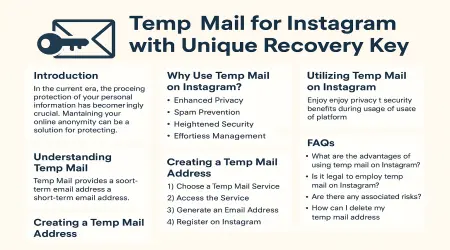

How Disposable Email Addresses Work: Technology & Benefits
Disposable email addresses act a lot like an umbrella you keep tucked away for those sudden downpours online. Whenever you face a sign-up form, a newsletter, or an e-commerce site, these single-use addresses give your real inbox a break. Here’s how it happens: messages zip through an intermediary, almost like a trusted middleman, so your primary address remains tucked safely out of view. If a disposable address starts to collect junk or gets tied up in a data breach (which, frankly, is more common than you’d think), you just drop it. That way, your main account remains tidy and safe, and you sidestep the hassle of endless spam or risks without any real downside.
How disposable email addresses work
The disposable email address (DEA) is sort of like a decoy, willing to take the hits for your actual account. You can create these alternates whenever needed, no complicated rituals, just a click or two, and delete them later, ensuring you control what lands in your real inbox and what doesn’t.
The basic lifecycle of a disposable address
Think of an email to a disposable address as going on a short journey, passing through a few key moments:
- Creation: Anyone can whip up a DEA by visiting a provider’s site, launching an app, or clicking a browser button. Some services let you get creative, picking your own username or even adding a custom domain if you want to stand out.
- Deactivation: And when the party’s over, you can axe that address instantly. As soon as you hit delete, it stops accepting mail, and depending on which provider you chose, those messages may bounce, vanish, or get rerouted elsewhere. Quite a few services will even do the dirty work by erasing the address automatically after a certain time. Actually, some vanish after minutes, others hang around for a few hours.
- Forwarding: But before all that, when someone sends mail to your DEA, it lands on the provider’s server first. That provider whisks your message along to your hidden, true inbox, as if passing it through a secret passage. The original sender never gets a peek at your real email.

The power of catch-all and wildcard domains
Some DEA services thrive on an astonishingly flexible foundation called catch-all or wildcard domain routing. You don’t need to register every specific address beforehand; their mail servers just shrug and accept anything you make up (such as youcandoanything@service.com). For the user, that means near-instant, unlimited alias creation, why not just invent a new inbox if you feel like it?
If no pre-existing rule matches the address, the system still lets messages in thanks to the catch-all setup. This easygoing flexibility is exactly what makes services like Mailinator so wild: simply hand out any address, and presto, it’s ready when needed.
How are these different from regular email aliases?
There’s some overlap between DEAs, aliases, and those things called masked emails, but their roles aren’t quite the same.
- DEAs are basically fast-burning matches: they’re meant to vanish after a short stint, sparing your privacy and keeping spam at bay.
- Aliases stick around longer. Think of them as semi-formal alternate addresses (like
info@mybusiness.comchanneling to your real inbox). They tidy up organization but aren’t sacrificial like DEAs. - Masked emails try to offer the best of both worlds. Each service you join gets its unique, durable proxy address; if things go bad, you can disable just one without disturbing the rest.

The core technical components of disposable email
Behind the curtain, disposable email relies on a team effort between specialized internet rules and server magic. These core elements ensure your stealth addresses work smoothly, juggling incoming messages and keeping your real inbox secure.
SMTP configurations for forwarding
Email delivery’s backbone, the good old Simple Mail Transfer Protocol (SMTP), takes center stage. For disposable emails, servers like Postfix or Exim are set up with detailed, care-driven rules.
- Alias Maps: Through neat little files (such as
virtual_alias_maps), the server knows how to route an incoming DEA straight to your main mailbox. This is the main trick for reliable forwarding. - Header Preservation: One sneaky problem is that authentication headers, like SPF, DKIM, and DMARC, often get mangled in transit. If a message hops over too many forwarding services, it might flag as spam. Experts advise forwarding directly from alias to inbox whenever possible.
- Routing Rules: Exim, for instance, lets you set up a
redirect routerthat makes the final decisions about where each email should go. This little feature prevents tricky loops that might otherwise tie your whole mail system in knots.

DNS records that make it all possible
The Domain Name System (DNS) acts a bit like air traffic control for email: it makes sure your messages land on the right server. Providers set up precise configurations for this to work well.
- MX Records: The crucial step is aiming the domain’s Mail Exchanger (MX) record, like
@simplelogin.com, to the service’s special servers. This means anyone sending email to your DEA will first hit the provider before going anywhere else. - Authentication Records: To avoid being labeled a spammer, providers post DNS records to establish trust, including:
- SPF (Sender Policy Framework): Lists who’s allowed to send mail for the domain, keeping impostors at bay.
- DKIM (DomainKeys Identified Mail): Signs outgoing messages digitally, confirming nothing got tampered with along the way.
- DMARC (Domain-based Message Authentication, Reporting & Conformance): Tells others what to do if an email flunks SPF or DKIM checks.
How headers are managed for privacy
Forwarding a message means the headers (think of them as footprints showing where the email traveled) are often massaged. Services such as AnonAddy tend to rewrite or hide fields like From and Reply-To so your personal address never leaks. Occasionally, they might add a header like X-Forwarded-For for their own tracking, and in a fair number of cases, detailed Received headers get passed along to help sort out any delivery issues. The goal is to balance keeping things traceable for troubleshooting, while aggressively protecting your privacy.

How specific services build their systems
Although the basics are shared, different providers have built their platforms with surprisingly creative approaches, sometimes aiming for mega-public inboxes, and sometimes focusing on private, temporary space that evaporates in no time.
The Mailinator model: public inboxes and wildcards
Mailinator is basically that extrovert of the disposable email scene, famous, open to everyone, and willing to let anyone crash the party. Its setup revolves around the catch-all system for maximum convenience.
- Wildcard Subdomains: Mailinator goes above and beyond simple aliases. Thanks to its wildcard MX records (written something like
* 1 IN MX test.mailinator.com.), anyone can send to made-up usernames and subdomains (for example,bob@randomstuff.mailinator.com). The result? An almost never-ending variety of addresses, all routed to Mailinator’s own servers. - Centralized MX Records: The domain’s MX entries all point to two main Mailinator mailboxes, which swiftly take in anything addressed to anyone, anytime.
- Dynamic Inbox Creation: No sign-up? No problem. As soon as an email lands for a new address, the system instantly creates an inbox “on demand”, ready to show its contents.
It’s clearly a system built for those who just need something quick and public, where the main concern is hiding from the sender, not from curious Mailinator browsers.
The 10MinuteMail model: ephemeral, high-volume architecture
Unlike the sprawling openness of Mailinator, 10MinuteMail is all about privacy and speed. It builds super-quick, self-destructing inboxes that barely stick around, which is perfect when you don’t want to leave a trace.
- Automatic Expiration: The star feature is how swiftly inboxes and their contents vanish, usually within ten minutes. This not only keeps things light on storage but practically guarantees nobody will find your data lingering around later.
- Token-Based Access: Instead of forcing users to sign up or wrestle with passwords, the system uses temporary, read-only tokens to let you check your messages through the web client and REST API. Scalability and anonymity go hand in hand.
- Edge-Native Databases: For speed, data is stored close to wherever you are in the world, using fancy but fast distributed databases like Turso. Sometimes, easier ones like SQLite step in for development.
- Lightweight SMTP Server: To keep everything secure and bare-bones, their server only picks up the essentials needed to receive mail, ducking the need to send messages or juggle complex options.

| Architectural Feature | Mailinator | 10MinuteMail |
|---|---|---|
| Primary Goal | Public, accessible, on-the-fly inboxes | Private, ephemeral, self-destructing inboxes |
| Inbox Creation | Dynamic, upon first email receipt | Pre-generated for a limited time |
| Privacy Model | Publicly viewable inboxes | Private to the user for the session |
| Key Technology | Wildcard MX records for unlimited addresses | Lightweight SMTP, edge databases, token auth |
| Data Retention | Messages stored for a few hours | Messages deleted after ~10 minutes |
What security and privacy features protect you
Today’s disposable email services go above just forwarding your mail; they place heavy emphasis on keeping your information locked down. Providers like AnonAddy and SimpleLogin have carved out a reputation by centering their services on strong encryption, reduced data footprints, and refreshingly open transparency.
Encryption for content and transit
If data protection was a fortress, modern disposable services would be stacking up the battlements with multiple layers of encryption.
- End-to-End Encryption (E2EE): By letting you use your GPG/OpenPGP public key, these services encrypt your messages before they ever leave. Only your matching private key can unlock them, so even the provider can’t pry into your secrets.
- Transport Layer Security (TLS): Whether your messages are being sent or received, TLS ensures everything is wrapped up in secure encryption, keeping snoopers away as messages move across the net.
- Data-at-Rest Encryption: Even stored details, like your actual email address or those public keys, get the AES-256-CBC treatment, shielding them from potential internal threats or thefts.

Data policies and logging practices
What’s just as reassuring is how stingy these services are with storing your info. Rather than hoard every detail, privacy-first providers opt for the bare minimum and toss most data quickly.
- No-Log or Minimal-Log Policies: Some, including AnonAddy and SimpleLogin, work almost as if they’re trying to forget you as fast as possible. Once a forwarded email leaves, it’s wiped from their servers.
- Log Rotation: Temporary records, like IP logs, are usually deleted in a matter of days. It’s not uncommon to see log data vanish within seventy-two hours or a week at most.
- Privacy-Focused Analytics: Instead of relying on mega-trackers such as Google Analytics, providers prefer lightweight, self-hosted solutions that ditch cookies and shun personal info altogether.
The role of open-source transparency
One surefire clue you’re dealing with a privacy-forward provider: they go open source. By publishing code to places like GitHub, platforms including SimpleLogin and AnonAddy invite the world to spot-check their claims, search for weaknesses, or even run private versions. That’s a rare openness that’s tough to fake.
When to use disposable emails: benefits and limitations
Disposable emails can be surprisingly powerful, but it’s worth remembering they don’t cover every possible use case. Let’s look at where they shine and where it’s best to steer clear.
Common use cases
- Protecting Your Primary Inbox: Every time you sign up for a forum, download a discount code, or register for a one-off event, a DEA is a great way to throw off spammers or shield yourself from unwanted attention.
- One-Time Registrations: For situations like public Wi-Fi gatekeepers or “grab this report” offers, DEAs make fine throwaways, once done, just walk away.
- Testing and Development: Developers love disposables. They simulate user sign-ups, reset flows, and notification pipelines in test environments without bloating real inboxes.
- Maintaining Anonymity: If you have to write or interact somewhere you prefer to keep at arm’s length, these addresses can be essential cloaks for your digital identity.

Key benefits and limitations
DEAs absolutely have their strengths, yet you should know about their quirks and potential setbacks, too.
| Benefits | Limitations |
|---|---|
| Enhanced Privacy | Blocked by Services |
| They shield your personal email from exposure, keeping your online identity safer. | A lot of modern websites are wise to DEA domains and might stop you from using them during registration. |
| Spam Control | Ephemeral Nature |
| Spam just gets isolated, if things get messy, delete the address and move on. | You really shouldn’t rely on these addresses for sensitive, long-term accounts, such as banks or social profiles. |
| Increased Security | Limited Functionality |
| They add an extra layer if a site you use suffers a data breach, it’s the DEA that gets exposed, not your main account. | A lot of free services won’t let you send attachments or reply, they’re just for receiving. |
| Automation for Developers | Public Inboxes |
| Super useful for integrating into automated testing setups and development flows. | Expect zero privacy from some public disposable inboxes, anyone may be able to view your incoming mail. |
What's next for disposable email technology
Disposable email keeps getting smarter. Instead of just throwing away addresses after each use, future systems are blending deeper technology and tighter security, pushing the whole concept well beyond simple “burners.”
Integration with blockchain and Web3
Emerging services are gearing up for the decentralized world. This new crowd serves crypto enthusiasts by allowing secure, anonymous messaging tailored to Web3 sensibilities.
- Platforms like Mailchain and Dmail Network are already enabling encrypted wallet-to-wallet chat.
- Atomic Mail, among others, is rolling out tools specifically for cryptocurrency users, like self-destructing messages and seed phrase recovery in a zero-access setup.
The rise of advanced dynamic aliasing
Frankly, the old lines between “alias” and “disposable” are blurring. Platforms such as SimpleLogin provide tools where you can easily make new aliases, attach your own domains, and send and reply without endangering your main address. The interface can be anything from a browser widget to a full-blown API for coders.
- Generate aliases as needed, no quota-limits in sight.
- Opt for personal domains or stick with shared ones for more control over your presence.
- Respond to emails or kick off new messages, always from a hidden base.
- Integrate with browser extensions, apps, and tidy developer tools.
AI's role in spam filtering and detection
With artificial intelligence getting sharper by the day, disposable email providers have a growing edge against spammers. But, just as quickly, businesses are fighting back by using smart filters to smoke out disposable addresses, so it’s a game of leapfrog all the way.
- Smarter Spam Filtering: Deep learning systems, sometimes built on frameworks like TensorFlow, snugly sift out even complex and creative spam, achieving accuracy scores north of 97%, leaving old-school filters trailing behind.
- DEA Detection: At the same time, companies use similar AI to block up new sign-ups if your address looks disposable, outsmarting users relying on these addresses for extra privacy.

Overall, disposable email has changed from being just a shield into a set of smart, flexible tools for protecting privacy online, a true Swiss army knife for the digital age. As privacy debates keep fueling demand, expect to see even more features baked natively into browsers, apps, and web platforms. In the end, these services are giving people a very real power: direct, everyday control over what happens to their personal data online.

